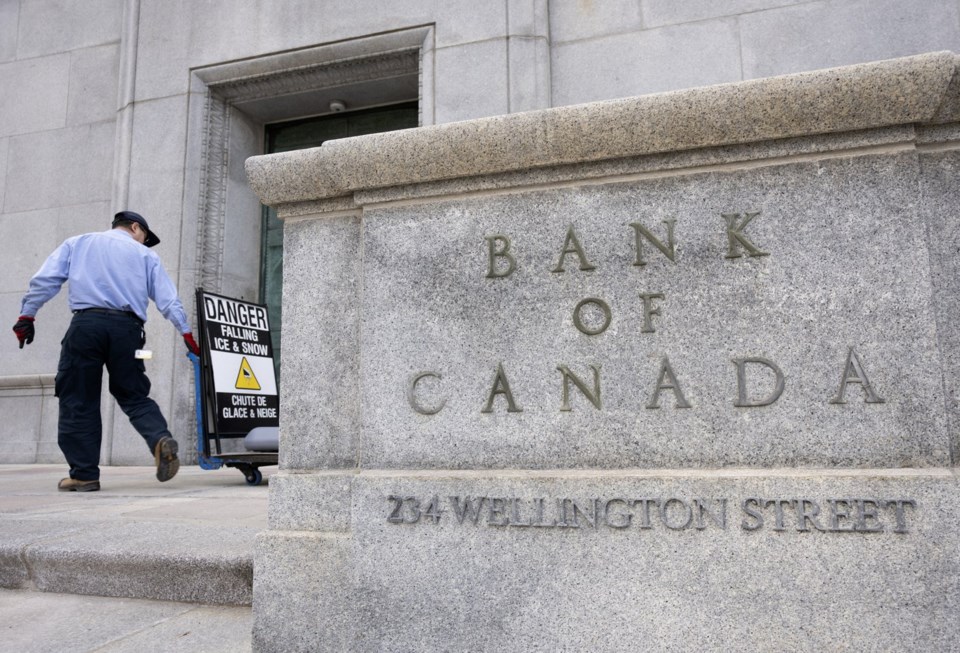OTTAWA — The Bank of Canada delivered another hefty interest rate cut as it acknowledged the economy has been weaker than it anticipated, but governor Tiff Macklem said Canadians should expect a slower pace of cuts moving forward.
The central bank's half-percentage point reduction on Wednesday marked the fifth consecutive time it's lowered its policy rate since June, bringing it to 3.25 per cent.
Forecasters were widely expecting the jumbo cut after the November labour force survey showed the unemployment rate rose to 6.8 per cent.
"Ultimately, (the Bank of Canada) felt it prudent with inflation back at the two per cent target to bring the policy rate back down to something that was no longer restrictive," said Randall Bartlett, a senior director of Canadian economics at Desjardins.
Macklem said in his prepared statement that the central bank opted for two large rate cuts in a row because economic growth doesn’t need to be restrained anymore.
However, the governor signalled Wednesday that the bank will likely slow down the pace of cuts going forward.
“The governing council has reduced the policy rate substantially since June, and those cuts will work their way through the economy,” Macklem said.
“With the policy rate now substantially lower, we anticipate a more gradual approach to monetary policy if the economy evolves broadly as expected.”
The bank's benchmark rate now sits at the upper bound of the neutral rate range.
The neutral rate, which the central bank estimates is somewhere between 2.25 per cent and 3.25 per cent, reflects a theoretical interest rate that will neither help nor hinder economic growth.
With inflation now back around two per cent over the last couple of months, the Bank of Canada is shifting its focus toward helping the economy recover.
Macklem mentioned in his remarks that economic growth came in weaker than the bank had forecast for the third quarter.
Looking ahead, the central bank says it expects growth next year to be weaker than previously forecast due to the federal government’s reduction in immigration.
Macklem also acknowledged the significant amount of economic uncertainty looming over Canada with the threat of U.S. tariffs.
"There's no question that if these tariffs were to move forward at the level suggested, it would be highly disruptive to the Canadian economy. It would also be very disruptive for the U.S. economy. Hopefully, that doesn't happen, but we did highlight it as a risk," the governor said.
The central bank will publish new forecasts for the economy on Jan. 29, following the U.S. presidential inauguration.
Economists are now widely anticipating the Bank of Canada to stick to quarter-point reductions in 2025.
"The Bank of Canada signalled that it's done with the big guns, but it likely still has bullets to fire as it eases rates with an eye to accelerating economic growth ahead," wrote CIСŔ¶ĘÓƵ chief economist Avery Shenfeld in a client note.
CIСŔ¶ĘÓƵ expects the central bank will lower its policy rate by a quarter-point at its next four meetings, bringing it to 2.25 per cent.
RСŔ¶ĘÓƵ is forecasting the benchmark rate to fall to two per cent by mid-2025. Economist Claire Fan said interest rates will need to fall into stimulative territory next year to jolt the economy back to a healthy pace of growth.
Federal Liberals, who have been struggling to make a political comeback since inflation and interest rates took off, were quick to celebrate the rate cut.
Prime Minister Justin Trudeau called it "a step in the right direction to bring down costs for Canadians" on X.
Finance Minister Chrystia Freeland told reporters on Parliament Hill the rate cut was "good news" and suggests the government's economic plan is working.
This report by The Canadian Press was first published Dec. 11, 2024.
Nojoud Al Mallees, The Canadian Press




